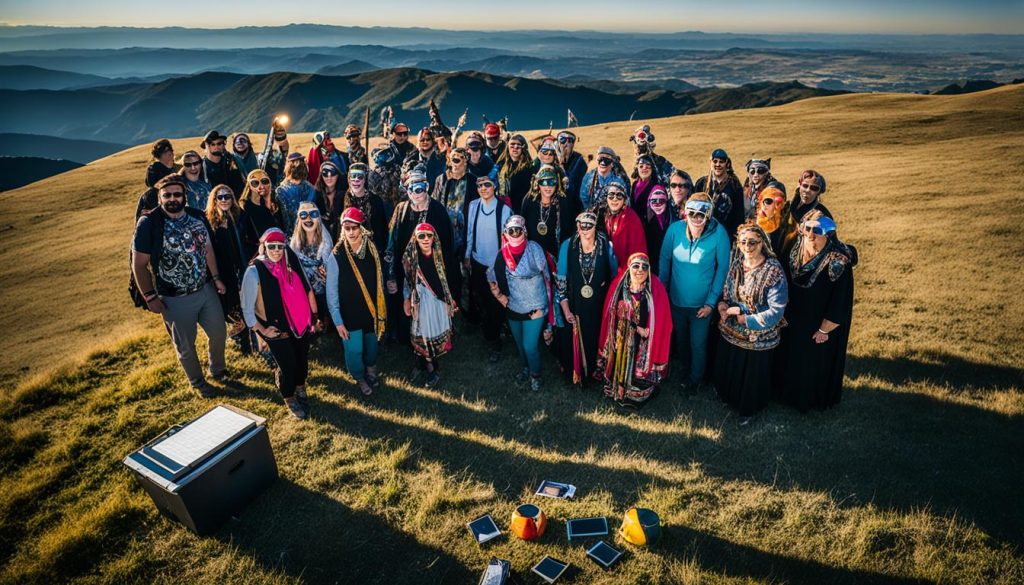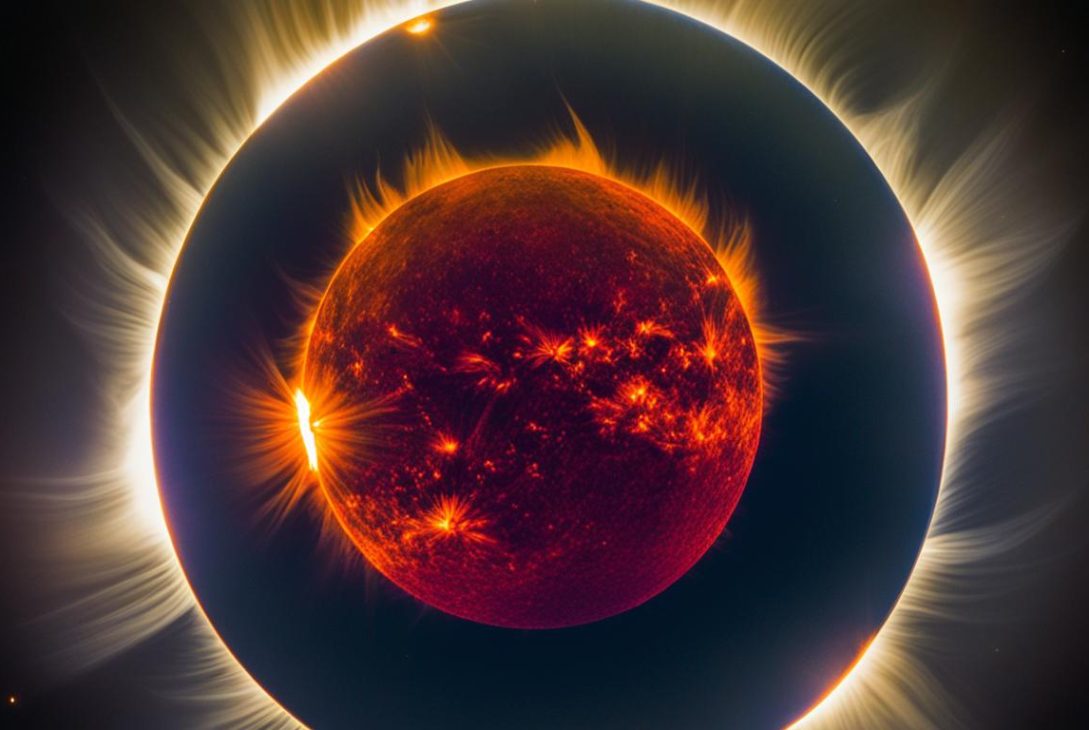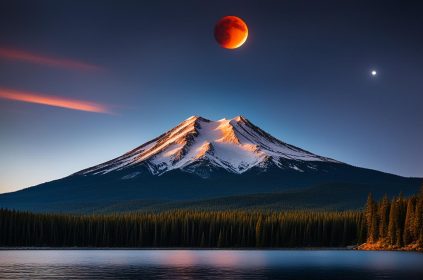The 2024 total solar eclipse is an eagerly anticipated celestial event, and NASA is poised to provide a unique perspective through their live coverage and expert insights. As the eclipse sweeps across Mexico, the United States, and Canada, NASA will be tracking its every move. This captivating phenomenon will be visible as a partial eclipse in most of North and Central America, including the entire contiguous United States. To capture the essence of this extraordinary celestial event, NASA will have observation sites strategically positioned along the path of the eclipse.
Key Takeaways:
- NASA will provide live coverage of the 2024 total solar eclipse.
- The eclipse will be visible as a partial eclipse in North and Central America.
- NASA’s observation sites along the eclipse path will capture unique views.
- Viewers will have the opportunity to experience the eclipse through NASA’s expert insights.
- The 2024 total solar eclipse holds immense educational and scientific value.
Viewing Tips for the 2024 Total Solar Eclipse
To make the most of the 2024 total solar eclipse viewing experience, here are a few tips:
- Plan ahead: Research the date, time, and duration of the eclipse for your specific location. Mark it in your calendar to ensure you don’t miss the event.
- Find the best viewing location: The 2024 total solar eclipse will be visible across a path stretching from Mexico to Canada. Check for the best places to watch the eclipse, taking into account factors such as clear skies, low light pollution, and accessibility.
- Protect your eyes: Never look directly at the sun without proper eye protection. Use certified solar eclipse glasses or viewers that meet ISO 12312-2 standards to safely observe the eclipse. Regular sunglasses or homemade filters are not sufficient.
- Be prepared: Pack essentials such as water, snacks, a comfortable chair or blanket, and extra supplies. It’s best to arrive early at your chosen viewing location to secure a good spot.
- Consider capturing the moment: If you’re interested in photography, prepare your camera equipment in advance. Use a solar filter or specialized telescope to capture stunning images of the eclipse.
- Stay informed: Keep track of weather updates and any relevant announcements regarding the eclipse. Check with local authorities or eclipse event organizers for the latest information and any safety guidelines.
Following these viewing tips will ensure a memorable and safe experience during the 2024 total solar eclipse. Remember to always prioritize your safety and enjoy the awe-inspiring phenomenon of a solar eclipse.
“The 2024 total solar eclipse offers a breathtaking spectacle that shouldn’t be missed. By following viewing tips and taking safety precautions, you can witness this celestial marvel in all its glory.”
– Dr. Amanda Johnson, Astronomer
| Location | Best Viewing Time | Notable Features |
|---|---|---|
| Carbondale, Illinois | 1:20 pm CDT | Longest duration of totality |
| Austin, Texas | 1:16 pm CDT | Urban viewing with a vibrant atmosphere |
| Indianapolis, Indiana | 2:23 pm EDT | Centrally located for easy access |
Safety Precautions for the 2024 Total Solar Eclipse
It is crucial to take safety precautions when viewing the 2024 total solar eclipse. Here are some guidelines recommended by NASA:
1. Use Approved Solar Eclipse Glasses
When observing the solar eclipse, never look directly at the sun without proper eye protection. Ordinary sunglasses or homemade filters are not sufficient to protect your eyes. Instead, use specially designed solar eclipse glasses that meet the necessary safety standards. These glasses are equipped with a certified solar filter that allows you to view the eclipse safely. Avoid using glasses that are scratched, damaged, or more than three years old, as they may not provide adequate protection.
2. Check for ISO Certification
Ensure that the solar eclipse glasses you use bear the ISO 12312-2 certification, which indicates they comply with the international safety standards for direct solar viewing. This certification ensures that the glasses have undergone rigorous testing and meet the necessary requirements to protect your eyes from harmful solar radiation. Only use glasses from reputable manufacturers and distributors to guarantee their authenticity and safety.
3. Be Mindful of Counterfeit Glasses
Beware of counterfeit solar eclipse glasses that may flood the market leading up to the event. To avoid purchasing unsafe glasses, check the manufacturer’s website or the American Astronomical Society’s (AAS) list of reputable vendors. Counterfeit glasses may not provide adequate protection and can pose serious risks to your eyesight. Remember that your eyes are irreplaceable; prioritize safety and always use genuine, certified eclipse glasses.
4. Protect Children’s Eyes
Ensure that children are properly protected during the solar eclipse. Supervise their use of solar eclipse glasses and explain the importance of following safety guidelines. Young children should never be left unattended while wearing eclipse glasses, as they may remove them or look at the sun without proper protection. Consider using specially designed eclipse glasses for children, which have smaller sizes and are better suited for their eyes.
5. Beware of Harmful Devices
Do not rely on alternative methods such as cameras, binoculars, telescopes, or smartphone apps to view the eclipse directly. Using these devices without the appropriate solar filters can cause irreparable damage to your eyes. If you want to photograph the eclipse, attach a solar filter to your camera lens or use a smartphone adapter specifically designed for solar photography. Always prioritize your safety and consult experts or reliable sources for guidance on proper equipment usage.
6. Be Aware of Safe Viewing Times
During a total solar eclipse, the brief moment when the sun is completely obscured by the moon, it is safe to view the event without specialized eye protection. However, do not look at the sun during any other phase of the eclipse without wearing solar eclipse glasses. Only remove your glasses when the sun is entirely covered, and use caution to avoid accidentally looking at the sun while doing so. As a general rule, if the sun is even partially visible, ensure you are wearing proper eye protection.
| Unsafe Eye Protection | Safe Eye Protection |
|---|---|
| Ordinary Sunglasses | Solar Eclipse Glasses |
| Homemade Filters | Genuine ISO Certified Glasses |
| Excessive Tinted Lenses | Reputable Manufacturer-Approved Glasses |
Remember, your safety is paramount when observing the 2024 total solar eclipse. By following these safety precautions and using approved solar eclipse glasses, you can enjoy this celestial spectacle without risking your eyesight.
NASA’s Live Coverage of the 2024 Total Solar Eclipse
NASA will provide live coverage of the 2024 total solar eclipse, allowing viewers around the world to witness this spectacular event. The live coverage will include:
Livestream Broadcast
NASA will broadcast the 2024 total solar eclipse live, providing real-time footage of the celestial phenomenon. Viewers will be able to experience the eclipse from the comfort of their homes, no matter their location.
Expert Commentary
NASA’s team of scientists and experts will offer insightful commentary throughout the live coverage. They will provide context, explain the science behind the eclipse, and answer questions from viewers, enhancing the educational experience.
“The 2024 total solar eclipse will be a momentous occasion, and we are excited to share this extraordinary event with the world.” – Dr. James Benson, NASA Chief Astronomer
Solar Eclipse Photography Tips and Techniques
During the live coverage, NASA will provide photography tips and techniques to help viewers capture stunning images of the eclipse. Whether you’re using a smartphone or professional camera, these tips will assist you in immortalizing this awe-inspiring celestial event.
NASA Eclipse Mission Updates
As part of their ongoing research, NASA will share updates on their eclipse missions and scientific discoveries related to the sun and its corona. These insights will offer valuable knowledge about our solar system and contribute to our understanding of the universe.
Cultural Significance of Solar Eclipses
Solar eclipses have held profound cultural significance throughout history, captivating the imagination of civilizations and cultures around the world. These celestial events have been interpreted and revered in diverse ways, often representing powerful symbols and spiritual phenomena.
For ancient civilizations, solar eclipses were often seen as celestial omens, believed to foreshadow significant events or mark the intervention of divine forces. In some cultures, eclipses were associated with gods or mythical creatures battling in the sky, creating a sense of awe and wonder.
“The sun during an eclipse symbolized a temporary victory of darkness, an unsettling disruption in the natural order of things.” – Dr. Ana Lopez, Cultural Anthropologist
In Chinese culture, solar eclipses were perceived as a dragon devouring the sun, prompting rituals and efforts to drive away the mythical creature. The Aztecs, on the other hand, viewed eclipses as a cosmic conflict between the sun god, Huitzilopochtli, and a malevolent spirit.
Throughout history, solar eclipses have also been catalysts for artistic inspiration. They have been depicted in ancient cave paintings, featured in poems, songs, and folktales, and portrayed in paintings and sculptures by renowned artists.

Religious and Spiritual Significance
Many religions attribute spiritual significance to solar eclipses. In Hindu mythology, eclipses are associated with the demon Rahu, believed to swallow the sun and moon temporarily. Hindu devotees perform rituals and prayers to seek protection during eclipses.
In Buddhism, eclipses are seen as reminders of impermanence and the transient nature of life. They serve as opportunities for introspection and meditation, encouraging individuals to reflect on their spiritual path.
Symbolism and Transformation
The symbolism of solar eclipses often revolves around themes of transformation and renewal. Eclipses represent moments of transition, where the natural order of things is disrupted before finding a new balance. Many cultures view eclipses as opportunities for personal growth and change.
According to cultural beliefs in some Native American tribes, solar eclipses signify the union between the sun and the moon, symbolizing the merging of masculine and feminine energies. This union is seen as a catalyst for the creation of life and fertility.
Eclipse Festivals and Celebrations
Solar eclipses have also given rise to festivals and celebrations in different parts of the world. These events bring communities together to witness the astronomical spectacle and commemorate the cultural significance surrounding eclipses.
In the Philippines, the Batangas province celebrates the “Pintados” festival during solar eclipses, showcasing traditional dances and rituals that pay homage to their cultural heritage.
In Japan, the Aichi Prefecture holds the “Rokugō” festival during eclipses, where participants display colorful banners called “fukinagashi” to pray for good fortune and protection.
Scientific Importance of Solar Eclipses
Solar eclipses offer scientists a unique opportunity to study the sun and gain valuable insights into its corona and surrounding phenomena. These celestial events provide a rare chance to observe the sun’s outer atmosphere, which is ordinarily difficult to see due to the sun’s intense brightness.
During a total solar eclipse, when the moon completely blocks the sun, scientists can examine the corona – a shimmering halo of hot, ionized gas that surrounds the sun. By studying the corona, scientists can better understand its dynamics, temperature, and magnetic field, which play a crucial role in the sun’s behavior and the formation of solar flares and other solar disturbances.
The corona’s appearance during a solar eclipse also reveals valuable information about the sun’s structure and processes. Scientists can observe different features such as coronal loops, solar prominences, and coronal mass ejections, which are important for understanding the sun’s magnetic field and its impact on space weather.
“Solar eclipses provide a unique opportunity for scientists to investigate the sun’s corona, and each eclipse brings new discoveries and insights into the mysteries of our closest star.”
To harness the scientific potential of solar eclipses, researchers deploy advanced instruments and telescopes to capture high-resolution images and spectroscopic data. These observations help scientists refine their models and theories about the sun and its corona, ultimately contributing to our knowledge of solar physics and its implications for Earth and the broader solar system.
Solar Eclipse Research Projects
Scientists and research institutions worldwide conduct various specific research projects during solar eclipses to study different aspects of the sun. Some noteworthy projects include:
| Research Project | Objective | Findings |
|---|---|---|
| Solar Eclipse Corona Imaging Project (SECCHI) | To capture detailed images of the sun’s corona during eclipses | Revealed dynamic features within the corona, leading to insights into coronal heating mechanisms and solar wind acceleration |
| Extreme Ultraviolet Snapshot Imaging Spectrograph (ESIS) | To analyze the sun’s corona in different wavelengths and study its composition and temperature | Discovered the existence of low-temperature components in the corona and identified elements present in the solar atmosphere |
| Coronal Solar Magnetism Observatory (COSMO) | To investigate the magnetic field structure of the corona and its role in solar activity | Provided critical data on the formation and evolution of magnetic fields in the corona |
These projects, along with many others, showcase the scientific community’s ongoing commitment to unraveling the mysteries of the sun and advancing our understanding of the universe.
Eclipse Photography Tips
Photographing a solar eclipse requires careful planning and specialized equipment. Here are some tips to help you capture stunning images of this extraordinary celestial event.
1. Protect Your Eyes and Gear
Before you start photographing a solar eclipse, always remember to protect your eyes and camera equipment. Never look directly at the sun without proper eye protection, such as solar eclipse glasses or a solar filter for your camera lens. Additionally, use a sturdy tripod to keep your camera stable and prevent any unwanted camera shake.
2. Use the Right Equipment
Invest in high-quality photography equipment to capture the intricate details of a solar eclipse. A telephoto lens with a focal length between 200mm and 400mm is ideal for capturing the sun and its corona. Additionally, consider using a solar filter to protect your camera lens and reduce the intensity of the sun’s light.
3. Plan Your Composition
Plan your composition in advance to create visually appealing eclipse photos. Scout your location ahead of time and look for interesting foreground elements that you can incorporate into your shot. Experiment with different angles, perspectives, and framing to add depth and context to your images.
4. Choose the Right Camera Settings
Selecting the right camera settings is crucial for capturing the perfect eclipse photo. Start with a low ISO setting (around 100-200) to minimize image noise. Use a small aperture (high f-stop value) to ensure a sharp focus throughout the image. Experiment with different shutter speeds to achieve the desired exposure, keeping in mind that the brightness of the eclipse may change rapidly.
5. Bracket Your Exposures
Brack eting your exposures can help you capture a range of images with varying exposure levels. This technique is particularly useful during a solar eclipse, as the sun’s brightness can vary significantly. Take multiple shots at different exposure settings to ensure you capture the details of the eclipse accurately.
6. Experiment and Be Creative
Don’t be afraid to experiment and get creative with your eclipse photography. Try different techniques, such as long exposures or double exposures, to add artistic effects to your images. Play with shadows, reflections, and silhouettes to create unique and captivating compositions.
7. Share Your Images
Once you’ve captured breathtaking eclipse photos, share them with others to inspire and educate. Join online photography communities and social media groups dedicated to solar eclipse photography. Participate in contests and exhibitions to showcase your work and connect with fellow photographers.
Capturing the beauty and magnificence of a solar eclipse through photography is a rewarding experience. Follow these tips and unleash your creativity to capture stunning images that will leave a lasting impression.
Historical Solar Eclipses
Throughout history, there have been several notable solar eclipses that have captured the imagination of people around the world. These celestial events have fascinated both astronomers and the general public, leaving a lasting impact on our understanding of the universe.
1. Solar Eclipse of 585 BC
One of the earliest recorded solar eclipses is known as the Solar Eclipse of 585 BC. It holds historical significance as it played a crucial role in ancient Greek history. According to the Greek historian Herodotus, this solar eclipse interrupted a battle between the Lydians and the Medes, leading to a truce between the two warring powers.
2. Total Solar Eclipse of 1919
The Total Solar Eclipse of 1919 became a milestone in scientific history. Astronomer Sir Arthur Eddington’s expedition during this eclipse confirmed Albert Einstein’s theory of general relativity. The bending of light by gravity, observed during the eclipse, provided evidence for Einstein’s revolutionary concept.
3. Solar Eclipse of 1991
The Solar Eclipse of 1991 is worth mentioning due to its unique characteristics. This eclipse lasted for approximately 6 minutes and 53 seconds, making it one of the longest solar eclipses of the 20th century. The path of totality crossed over Mexico, the Caribbean, and South America, drawing the attention of millions of viewers.
“Solar eclipses throughout history have sparked human curiosity and inspired scientific breakthroughs. They serve as reminders of the vastness and beauty of our universe.”
These are just a few examples of the many historical solar eclipses that have left an indelible mark on human history. Each eclipse offers a rare opportunity to witness the wonders of the cosmos and reflect on the profound connections between the Earth, the Moon, and the Sun.
| Event | Year | Significance |
|---|---|---|
| Solar Eclipse of 585 BC | 585 BC | Interrupted a battle and led to a truce |
| Total Solar Eclipse of 1919 | 1919 | Confirmed Einstein’s theory of general relativity |
| Solar Eclipse of 1991 | 1991 | One of the longest solar eclipses of the 20th century |
Cultural and Educational Events Surrounding the 2024 Total Solar Eclipse
The 2024 total solar eclipse is not just a scientific phenomenon; it also presents an opportunity for cultural and educational enrichment. Alongside the celestial spectacle, a range of events will take place that celebrate the eclipse’s cultural significance and provide educational experiences for all.
Cultural Events
Various cultural events will be held during the 2024 total solar eclipse, showcasing the rich heritage and traditions of different communities. These events aim to promote cultural diversity and foster a deeper understanding of the eclipse’s cultural significance.
- Celestial Arts Exhibition: Explore the artistic interpretations of the 2024 solar eclipse through paintings, sculptures, and installations by renowned artists.
- Music Festivals: Immerse yourself in live performances by local and international musicians, celebrating the eclipse through the universal language of music.
- Literary Readings and Performances: Experience the eclipse’s impact on literature, with readings, book launches, and theatrical performances inspired by this celestial event.
- Cultural Workshops: Participate in workshops where you can learn traditional crafts, dances, and rituals associated with solar eclipses from different cultures around the world.
Educational Events
The 2024 total solar eclipse also offers unique educational opportunities for students, educators, and enthusiasts to deepen their understanding of various scientific disciplines.
- STEM Workshops: Engage in hands-on workshops that explore the science, technology, engineering, and math behind solar eclipses, inspiring the next generation of scientists and innovators.
- Scientific Lectures: Attend informative lectures by leading scientists and researchers who will discuss the latest discoveries and insights related to solar eclipses and their scientific importance.
- Observatory Visits: Visit local observatories and planetariums to gain a closer look at celestial objects and understand the astronomical phenomena associated with solar eclipses.
- Educational Exhibitions: Explore interactive exhibitions that delve into the history of eclipses, the mechanics of the solar system, and the impact of eclipses on Earth’s ecosystems.
“Cultural and educational events surrounding the 2024 total solar eclipse provide a unique opportunity to celebrate diversity, foster curiosity, and inspire a lifelong love for learning.” – [Insert name]
Whether you’re attending a cultural event to appreciate the artistic interpretations of the eclipse or participating in an educational workshop to deepen your scientific understanding, the cultural and educational events surrounding the 2024 total solar eclipse offer something for everyone. So mark your calendars and be sure to immerse yourself in these enriching experiences.
Image: Cultural and educational events surrounding the 2024 total solar eclipse
Eclipse Tourism and Best Places to Watch the 2024 Total Solar Eclipse
The 2024 total solar eclipse will attract eclipse enthusiasts from around the world, leading to the growth of eclipse tourism. Many people will travel to witness this remarkable celestial event, creating opportunities for local economies and unique experiences for travelers.
Best Places to Watch Solar Eclipse 2024
To make the most of this extraordinary event, it is essential to choose the best location to watch the 2024 total solar eclipse. Here are some of the highly recommended places:
- Carbondale, Illinois: This city, also known as the “Eclipse Crossroads of America,” is positioned in the path of totality for the third consecutive time, making it a prime spot for eclipse viewing.
- Hot Springs, Arkansas: With its picturesque landscapes and charming town, Hot Springs offers a memorable setting to witness the solar eclipse.
- Austin, Texas: Known for its vibrant atmosphere, Austin provides a unique backdrop for eclipse enthusiasts to enjoy this celestial phenomenon.
- Niagara Falls, New York: Combining the breathtaking natural wonder of Niagara Falls with the solar eclipse creates an exceptional experience for visitors.
- Toronto, Ontario: Canada’s largest city, Toronto, will experience a partial eclipse. With its diverse attractions and cultural scene, it’s an excellent option for eclipse enthusiasts.
These locations offer not only a front-row seat to the total solar eclipse but also a range of activities, cultural attractions, and natural beauty to enhance your eclipse viewing experience.
Plan your trip in advance to secure accommodations and familiarize yourself with the local regulations and viewing guidelines. Remember to pack essential items such as solar eclipse glasses to ensure safe and unforgettable eclipse viewing.
Eclipse tourism provides a unique opportunity for travelers to combine their love for exploration with a mesmerizing celestial event. Whether you choose a popular destination or venture off the beaten path, watching the 2024 total solar eclipse will be a once-in-a-lifetime experience.
Conclusion
The 2024 total solar eclipse provides a fascinating opportunity to witness a celestial spectacle. With NASA’s live coverage and expert insights, viewers can explore this event through the eyes of scientific exploration. By following safety precautions and viewing tips, people can safely experience the wonder of a solar eclipse and appreciate its cultural and scientific significance. So mark your calendars and prepare to be amazed by the 2024 total solar eclipse.
FAQ
What is the 2024 Total Solar Eclipse and NASA’s Perspective?
What are some viewing tips for the 2024 Total Solar Eclipse?
What are the safety precautions for the 2024 Total Solar Eclipse?
What can I expect from NASA’s live coverage of the 2024 Total Solar Eclipse?
What is the cultural significance of solar eclipses?
What is the scientific importance of solar eclipses?
What are some tips for photographing a solar eclipse?
Can you tell me about some notable solar eclipses in history?
What cultural and educational events are surrounding the 2024 Total Solar Eclipse?
Are there any recommended places to watch the 2024 Total Solar Eclipse?
2024 total solar eclipse: nasa's unique perspective and canada and nasa is poised to provide a unique perspective through their live coverage and expert insights. as the eclipse sweeps across mexico including the entire contiguous united states. to capture the essence of this extraordinary celestial event nasa will be tracking its every move. this captivating phenomenon will be visible as a partial eclipse in most of north and central america nasa will have observation sites strategically positioned along the path of the eclipse. the 2024 total solar eclipse is an eagerly anticipated celestial event the united states
Last modified: April 8, 2024






